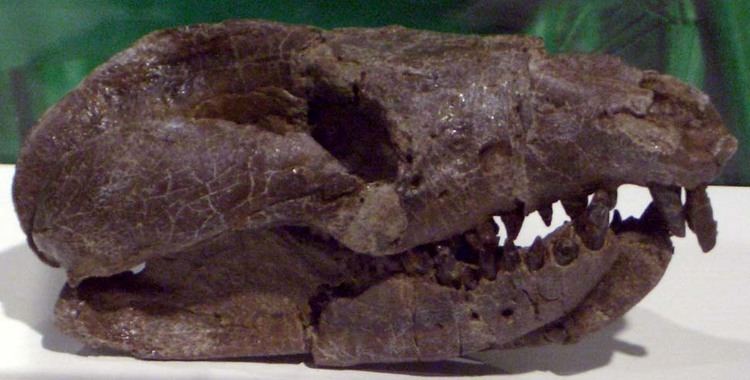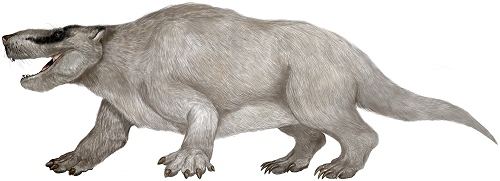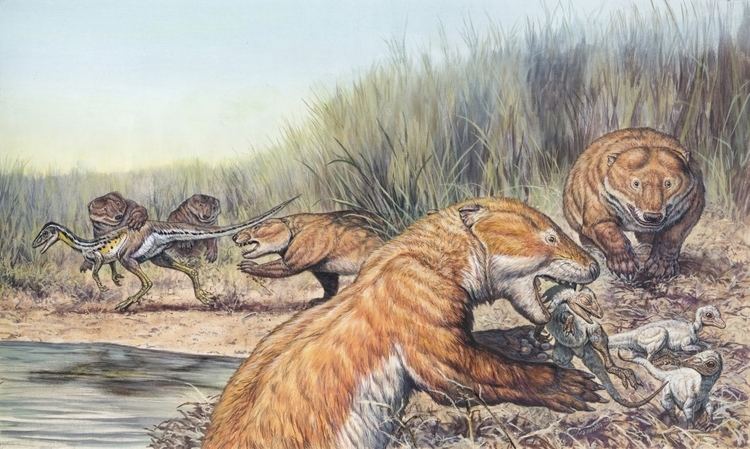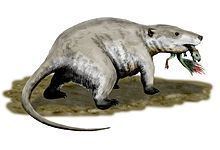Phylum Chordata | Class Mammalia Scientific name Repenomamus Rank Genus | |
 | ||
Similar Eutriconodonta, Volaticotherium, Castorocauda, Gobiconodon, Eomaia | ||
Repenomamus is a gobiconodontid mammal genus containing two species, Repenomamus robustus and Repenomamus giganticus. Both species are known from fossils found in China that date to the early Cretaceous period, about 125-123.2 million years ago. R. robustus is one of several Mesozoic mammals for which there is good evidence that it fed on vertebrates, including dinosaurs, though it is not possible to determine if it actively hunted live dinosaurs or scavenged dead ones. R. giganticus is among the largest mammals known from the Mesozoic era.
Contents

Classification and discovery

The fossils were recovered from the lagerstätte of the Yixian Formation in the Liaoning province of China, which is renowned for its extraordinarily well-preserved fossils of feathered dinosaurs. They have been specifically dated to 125-123.2 million years ago, during the Early Cretaceous period.

Repenomamus is a genus of triconodonts, a group of early mammals with no modern relatives. R. robustus was described by Li, Wang, Wang and Li in 2000, and R. giganticus was described by Hu, Meng, Wang and Li in 2005. The two known species are the sole members of the family Repenomamidae, which was also described in the same paper in 2000. It is sometimes alternatively listed as a member of the family Gobiconodontidae; although this assignment is controversial, a close relationship to this family is well-founded.
Description

Individuals of the known species in Repenomamus are the largest known Mesozoic mammals represented by reasonably complete fossils (though Kollikodon may be larger, and Schowalteria, Oxlestes, Khuduklestes and Bubodens reached similar if not larger sizes), adults of R. robustus were the size of a Virginia opossum with an estimated mass of 4–6 kg (8.8–13 lb) while the known adult of R. giganticus was about 50% larger with a total length of around 1 m (3 ft 3 in) and an estimated mass of 12–14 kg (26–31 lb). These finds extend considerably the known body size range of Mesozoic mammals. In fact, Repenomamus was larger than several small sympatric dromaeosaurid dinosaurs like Graciliraptor. Features of its shoulder and legs bones indicate a sprawling posture as in most of small to medium sized living therian mammals, with plantigrade feet. Unlike therian mammals, Repenomamus had proportionally longer bodies with shorter limbs.

The dental formula was originally interpreted as 3.1.2.42.1.2.5, though a more recent study indicates instead that it was 3.1.1.52.1.2.5.
Paleobiology
Features of the teeth and jaw suggest that Repenomamus were carnivorous and a specimen of R. robustus discovered with the fragmentary skeleton of a juvenile Psittacosaurus preserved in its stomach represents the second direct evidence that at least some Mesozoic mammals were carnivorous and fed on other vertebrates, including dinosaurs; a reccorded attack on an Archaeornithoides by a Deltatheridium predates its description. Speciations towards carnivory are known in eutriconodonts as a whole, and similarly large sized species like Gobiconodon, Jugulator and even Triconodon itself are thought to have tackled proportionally large prey as well; evidence of scavenging is even assigned to the former.
Like most other non-therian mammals, Repenomamus had an epipubic bone, meaning that it gave birth to or laid eggs that hatched into undeveloped young like modern marsupials and monotremes.
